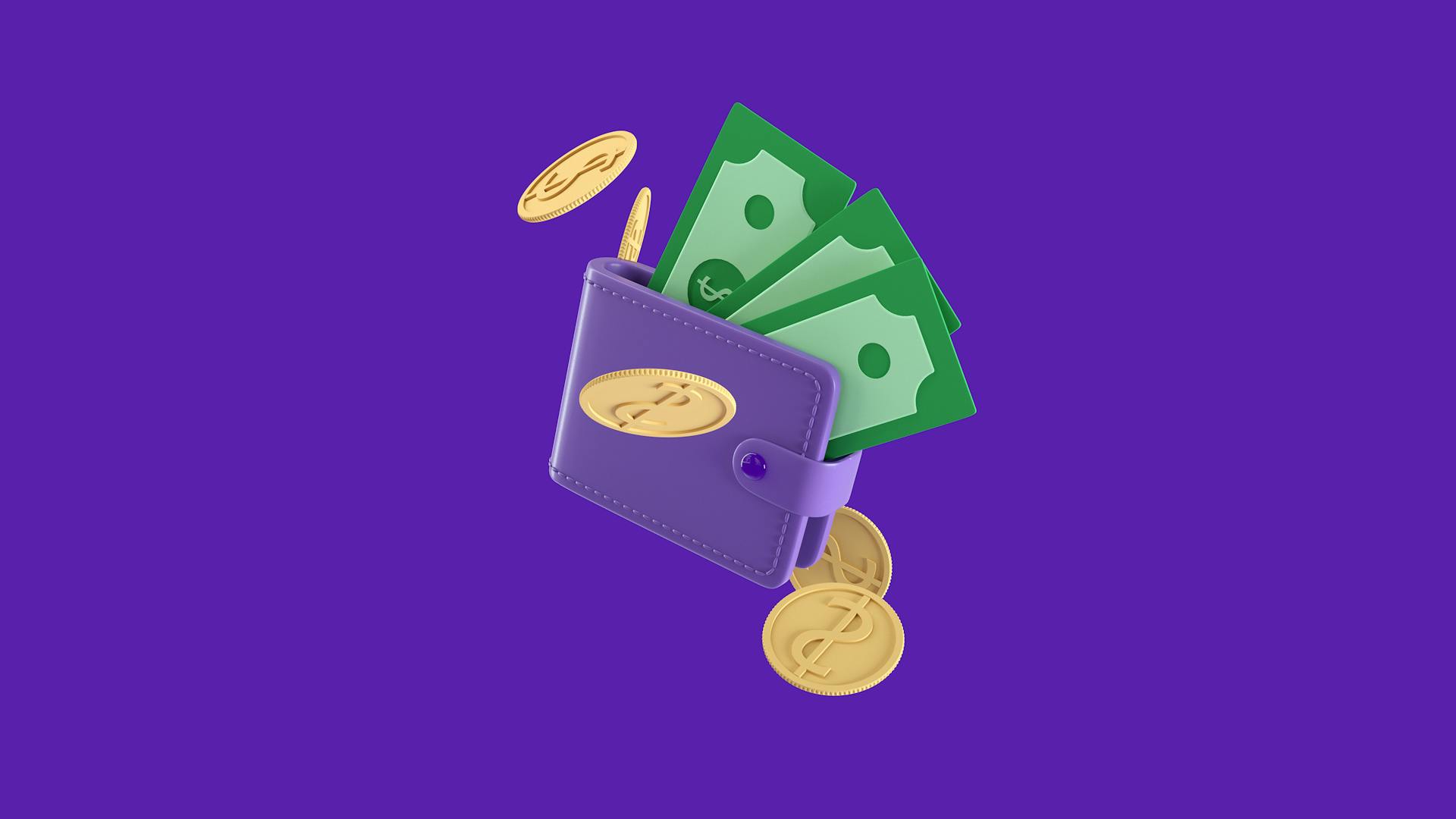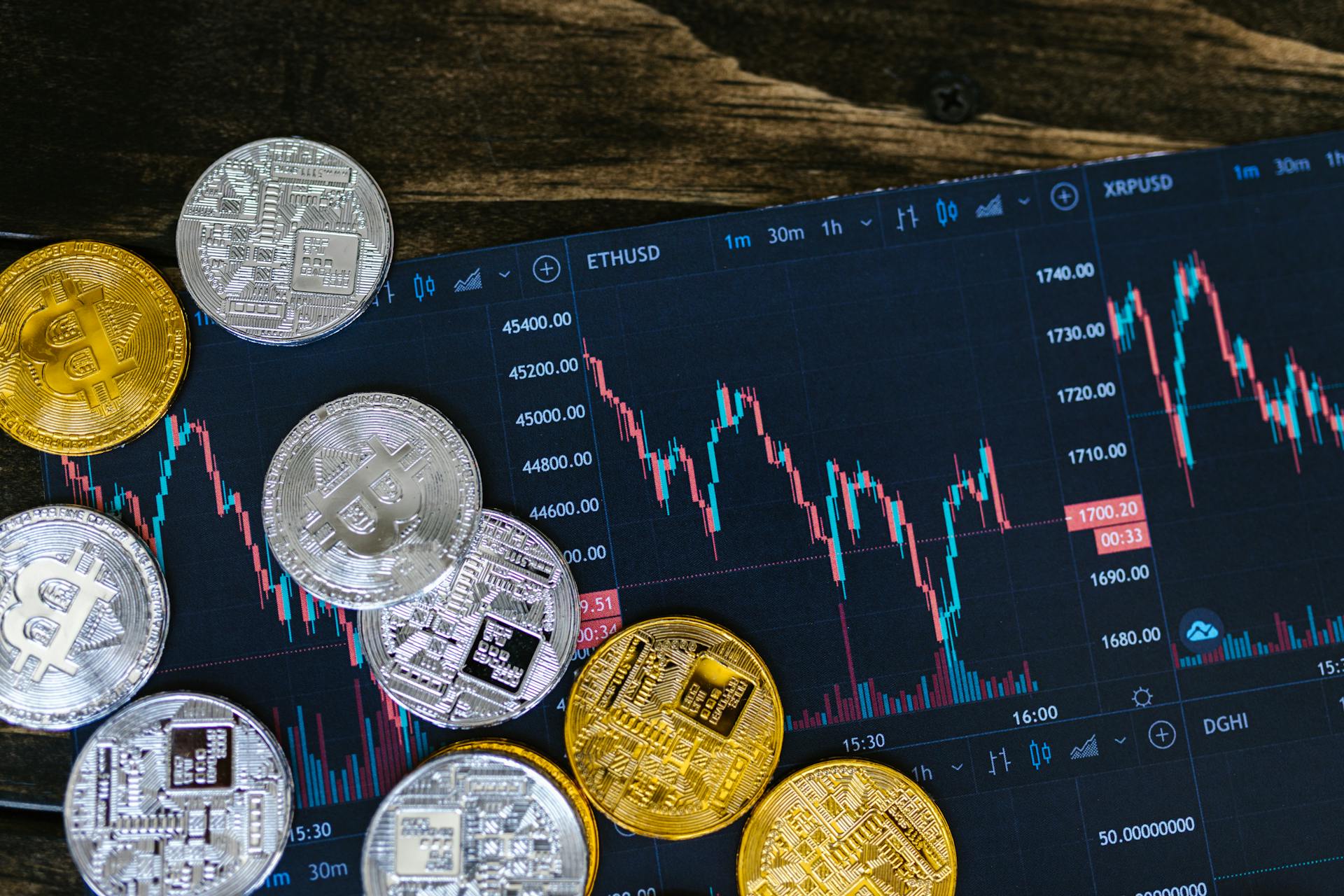
Understanding gold investment returns can be a complex and intimidating topic, but it's essential to grasp the basics to make informed decisions. Historically, gold has outperformed many other investments over the long term.
Gold's value tends to increase during times of economic uncertainty, such as inflation or recession. This is because gold is a safe-haven asset that investors turn to when they're unsure about the future.
One key factor to consider is the role of inflation in gold investment returns. Inflation can erode the value of other investments, but gold's value tends to rise with inflation. This is because gold is a tangible asset that retains its value even when paper currencies lose purchasing power.
Investors can expect gold to perform well in times of economic stress, such as during a recession.
Consider reading: Historical Rates of Return by Asset Class
Historical Performance
Gold has been around for centuries, but its performance over the past few decades is what really matters to investors. Over the past 50 years, gold prices have changed significantly, influenced by various economic and political events.
From 1972 to 1980, gold prices rose dramatically, reaching a record high of around $840 in 1980, which is equivalent to over $3,000 in today's dollars. This was largely due to double-digit inflation in the US and political tensions like the Soviet invasion of Afghanistan and oil embargoes.
The 1980s and 1990s saw a decline in gold prices as inflation cooled and the stock market boomed. Gold traded between $300 and $500 per ounce for nearly 20 years before sinking to near-term lows by 2000.
However, gold regained its luster in the 2000s, almost doubling from $500 in 2005 to over $1,000 by 2008. The 2008 financial crisis was a significant turning point for gold prices, as investors bought gold as a safe-haven asset, causing its price to surge to an all-time high near $1,900 in 2011.
Here's a summary of gold's historical performance over the past few decades:
As you can see, gold's performance has varied over the years, but it has generally been a stable investment option. However, it's essential to remember that past performance doesn't guarantee future results, and investors should always maintain a well-diversified portfolio that includes several asset classes.
Explore further: Scion S Capital Meaning Michael Burry
Investment Benefits
Over the past 30 years, U.S. stocks have performed best, generating an annualized total return of 10% before inflation and 7.3% after inflation.
The 10-year Treasury note delivered an annualized return of 3.8% over the same span, but this drops to 1.3% when adjusted for inflation.
Gold, on the other hand, generated an annualized return of 6.1% before inflation and 3.5% after inflation, trailing both bonds and stocks.
Gold often loses value in prosperous times, as the 1990s generally were, and it dropped about 27% between 1989 and 1999.
However, gold can indeed be a good hedge in a crisis, as it soared in value during hard times, such as the COVID-19 pandemic and the 2008 financial crisis.
For another approach, see: Pensions Crisis News
A Good Hedge
Gold has historically been a good hedge against economic downturns and market volatility. Over the past 30 years, it has generated an annualized return of 6.1% before inflation, making it a potentially attractive option for investors looking to diversify their portfolios.
In times of crisis, gold often soars in value as investors seek safety. Just look at 2020, when the COVID-19 pandemic caused a significant selloff in stocks, but gold prices held firm and then rallied 36% over the next four-plus months.
The 21st century has given gold several opportunities to shine, including the turmoil following the 9/11 terrorist attacks and the 2008-09 economic meltdown. These events demonstrate gold's potential to perform well in times of economic uncertainty.
Gold's historically low correlation to other asset classes, such as stocks and bonds, makes it a potentially valuable addition to a portfolio. This means that gold prices often move independently of other financial markets, providing a buffer against market downturns or volatility.
By adding gold to a portfolio, investors may be able to improve risk-adjusted returns and reduce overall portfolio volatility. Some portfolio optimization studies suggest that putting a small part of an investment portfolio in gold can improve risk-adjusted returns.
Here's an interesting read: Bill Ackman New York Times
Financial Assets Over Physical Goods
Investing in gold funds is a more convenient option than holding physical gold, as it eliminates the need to store and insure the metal.
The SPDR Gold Shares (GLD) is the world's largest gold-backed exchange-traded fund, with about $75 billion in assets.
It tracks the price of gold bullion, providing a straightforward way to get gold exposure.
The iShares Gold Trust (IAU) is a lower-cost alternative, with annual expenses of 0.25% compared to 0.40% for GLD.
You can also invest in mutual funds and ETFs that invest in the stocks of gold-mining companies.
Intriguing read: Spdr Gold Shares Gld
Potential Returns
Over the past 20 years, a $200 investment in gold could have achieved a 550% return, or 10.6% annual growth rate, if invested in September 2004. This is a remarkable return, especially considering the volatility of the gold market.
In comparison, investing $200 in gold in September 2011 near its previous peak of $1,900 would have only generated a 43% total return, or 2.8% annualized over 13 years. This highlights the importance of entry timing and the variability of returns.
A $200 investment in gold over 20 years could grow to $1,345 with a 10% compounded annual growth rate (CAGR). This is a significant increase, and it's essential to consider your own views and risk tolerance when evaluating the potential returns of gold.
Here's a rough breakdown of how different CAGRs could impact a $200 gold investment over 20 years:
These scenarios illustrate the power of compounding over long time horizons, but it's essential to remember that gold's actual growth rate is unlikely to be smooth or predictable.
Market Factors
Market factors play a significant role in shaping gold investment returns. Economic growth and rising corporate profits can make gold less attractive, causing it to underperform compared to stocks.
During recessions or bear markets, gold tends to do better as people seek it as a safe haven. This is because gold is often used as a store of value when other assets decline.
A stronger U.S. dollar can make gold more expensive for foreign holders, potentially lowering international demand. Conversely, a weaker dollar can boost gold's appeal as an alternative store of value.
Supply and Demand
Gold prices are heavily influenced by the delicate balance of supply and demand. Gold mining adds to supply each year, but the overall supply grows very slowly since most of the metal ever mined remains in existence as a store of value.
Jewelry fabrication and electronics manufacturing create a base level of demand for gold. Gold is also sought for investment purposes, which can fluctuate based on economic conditions and market sentiment.
For many, gold is an evergreen investment that remains consistently popular with retail investors. Many years, it's even more popular than stocks for investment purposes.
Market Conditions
Gold prices can be significantly impacted by broader financial market conditions. During periods of strong economic growth and rising corporate profits, gold may not perform as well as assets like stocks.
Recessions or bear markets, on the other hand, tend to be good times for gold. This is because many people fleeing the stock market use gold as a safe haven to store some of their capital.
A stronger economy can make gold less attractive, but a weaker economy can boost its appeal. This is a key consideration for investors looking to diversify their portfolios.
In times of economic uncertainty, gold's value tends to rise as people seek safe havens. This is a natural response to risk, and it's a key driver of gold's price movements.
Momentum and Sentiment
Momentum and Sentiment play a significant role in the gold market. During bull markets, rising prices attract more buyers, fueling further gains.
In bull markets, the increase in value itself attracts more buyers, creating a self-reinforcing cycle. This is why professional investors and speculators can build on these momentum swings by trading large quantities of gold futures or ETFs.
Media coverage, analyst forecasts, and technical chart patterns can also shape short-term gold market sentiment. This is especially true for professional investors who closely follow market trends and news.
Professional investors and speculators can capitalize on these momentum swings by making informed trades. They can use their knowledge of market trends and news to make smart investment decisions.
Investor sentiment can shift quickly, making it essential for investors to stay informed and adapt to changing market conditions.
Here's an interesting read: Momentum Investing News
External Influences
External Influences can significantly impact your gold investment returns. Gold prices are shaped by a range of economic, political, and market forces that interact, making it essential to stay attentive to gold's ever-changing fundamentals.
Political instability can dramatically boost demand for gold, as seen in 1980 when gold prices surged to then-record highs following the Soviet invasion of Afghanistan. Tensions in the Middle East have also helped fuel a gold rally in recent years.
Central banks, like the People's Bank of China, hold gold as part of their reserves, and their buying or selling can move the market. This can lead to significant fluctuations in gold prices.
Other external factors to consider include:
- ETF inflows/outflows: Flows in and out of gold-backed ETFs, such as the SPDR Gold Trust (GLD), can certainly affect prices.
- Mining technology: Changes in gold mining output at the margins can influence the balance of supply and demand over time.
- Crypto competition: The rise of cryptocurrencies like bitcoin is an emerging factor in the gold market, potentially diverting demand away from gold among younger investors.
Political Events
Gold prices are particularly sensitive to political instability, which can dramatically boost demand for gold and its perceived safety. This is due to its long history as a universally recognized store of value and safe haven asset.
Wars, terrorist attacks, natural disasters, and other shocks can all impact gold prices. For example, gold prices surged to then-record highs in 1980 following the Soviet invasion of Afghanistan.
For your interest: How to Track Gold Prices
Tensions in the Middle East have helped fuel a gold rally more recently. These acute events can have a significant impact on gold prices.
Slow-burning global trends, such as the rise of China, can also shape gold's outlook over longer periods. The supposed decline of U.S. hegemony may also influence gold prices.
Expand your knowledge: Historical Gold and Silver Prices
The Fed and Monetary Policy
The Fed's decisions have a significant impact on the gold market, often causing gold prices to fluctuate. By setting short-term interest rates and controlling the money supply, the Fed influences real interest rates and the dollar's value.
Quantitative easing tends to be bullish for gold, as it depresses real interest rates and the dollar. Conversely, rate hikes and quantitative tightening can create headwinds for gold, making it less valuable.
The Fed's actions can be unpredictable, but one thing is certain: their decisions affect gold prices. In 2013, gold sold off sharply during the "Taper Tantrum" after the Fed suggested it would wind down asset purchases.
A fresh viewpoint: Quantitative Hedge Fund Salary
Other Factors
Central banks like the People's Bank of China have been steadily accumulating gold since 2019, which can move the market.
Flows in and out of gold-backed ETFs like the SPDR Gold Trust (GLD) can certainly affect prices. This is because ETFs are very popular investment vehicles.
Mining technology is a slow-moving factor, but changes in gold mining output can influence the balance of supply and demand over time.
The rise of cryptocurrencies like bitcoin is an emerging factor in the gold market. However, the rise in the value of bitcoin has not affected the similar rise in the price of gold between 2023 to 2024.
Here are some key factors to consider:
- Central bank demand
- ETF inflows/outflows
- Mining technology
- Crypto competition
Frequently Asked Questions
What if I invested $1000 in gold 10 years ago?
If you invested $1000 in gold 10 years ago, it would be worth approximately $2,111.22 today, a return of 111.22%.
What is the annual rate of return of gold?
Gold's average annual return is around 7.98%, slightly behind commodities, but with a notable 13.1% return in 2023
Is gold currently a good investment?
Yes, gold is currently a good investment opportunity, with prices at attractive levels below recent highs. Consider adding gold to your portfolio for potential long-term growth.
What is the 20 year return on gold?
The 20-year total return on gold is a staggering 543% with a compound annual growth rate of 9.8%. This impressive performance makes gold a compelling investment option for long-term wealth growth.
Sources
- https://www.kiplinger.com/slideshow/investing/t026-s001-investing-in-gold-10-facts-you-need-to-know/index.html
- https://www.investopedia.com/investing-usd200-in-gold-8715076
- https://www.gold.org/goldhub/research/golds-long-term-expected-return
- https://awealthofcommonsense.com/2024/03/whats-the-investment-case-for-gold/
- https://www.cbsnews.com/news/which-gold-investment-is-best-when-rates-are-cut/
Featured Images: pexels.com


